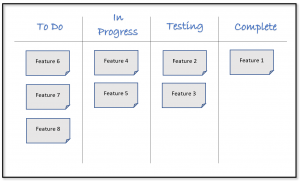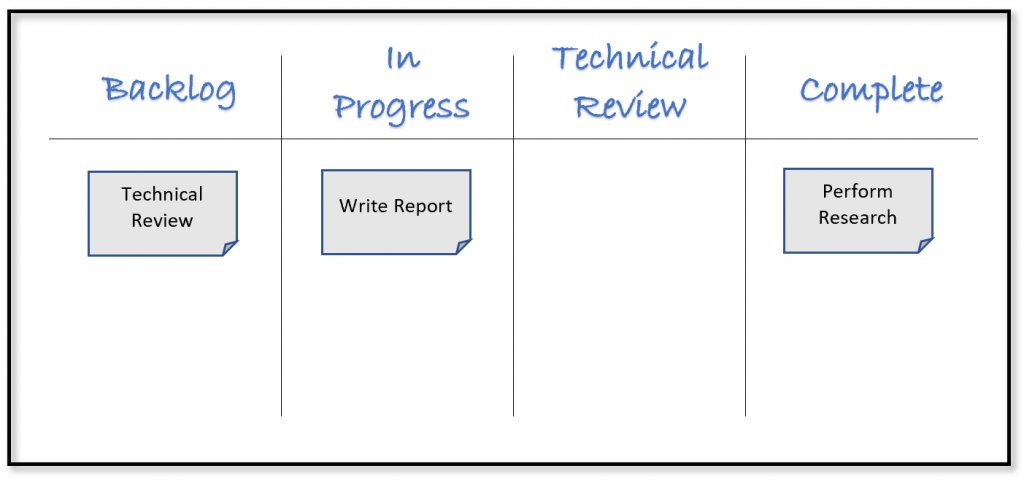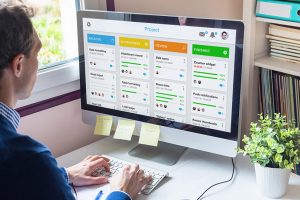
Kanban is a task scheduling method originally developed by the Toyota Production System in the 1960’s to track inventory levels. Although it is being still used in some manufacturing plants, today kanban has obtained greater use in the software industry to manage work in progress.
It is one of those simple, yet amazingly effective tools that most people who have adopted it wonder how they ever did without.
Kanban, or signboard in japanese, uses a series of display cards to represent work items which move horizontally across the “kanban board” as the work progresses. The cards typically move through columns called:
- Backlog
- In progress
- Testing
- Complete

This is the typical software project setup. In a lean manufacturing plant (the successor to the Toyota Production System), a kanban is started in response to a customer order and proceeds with the raw materials through the manufacturing process in a system of:
- Inventory required
- Inventory ordered
- Inventory delivered
The setup possibilities are as endless as the individual business needs of the organization, however the constant principle is that a series of work packages proceed chronologically from left to right in a series of milestones.
Kanban boards are a strong project management technique in service businesses such as software, consulting, accounting, and engineering.
How to Create a Kanban Board
There are three steps to setting up a kanban board:
- Firstly, the appropriate project milestones are placed along the top, in columns. They can be either technical milestones, for example “Submit report,” or generic task-based milestones, like “Not started / In progress / Complete.”
- Secondly, the project is divided into tasks. This is one of the foundational building blocks of project management therefore it is not specifically part of the kanban process.
- Thirdly, each project task is placed on a card. This can be a sticky note on a physical board, or an entry in a project management software product that is set up to use kanban boards. In agile project management methodology, the user stories are placed on the board alongside their constituent project tasks.
Each task starts on the left most column which is called “to do” or “backlog” (or similar), and proceeds from left to right through the project milestones.
Kanban Board Example
For example, a simple project to perform some background research and write a report might have the following three tasks:
| ID | Name |
|---|---|
| 100 | Perform Research |
| 200 | Write report |
| 300 | Technical Review |
Each task is initially placed in the first (left) column on the kanban board. It is determined that there will be four milestones, called:
- Backlog
- In progress
- Technical Review
- Complete
Therefore, the final kanban board looks like this:
 The project tasks proceed from left to right, through each column.
The project tasks proceed from left to right, through each column.
Very simple, yes, but that is precisely where it derives its power.
What are the Benefits of Using a Kanban Board?
 Software projects using kanban report a high level of productivity relative to traditional project management (gantt charts). This is for several reasons:
Software projects using kanban report a high level of productivity relative to traditional project management (gantt charts). This is for several reasons:
- They ensure that nothing is left behind. When many work packages must be progressed and tracked through their respective milestones simultaneously, the kanban board is without equal. The project manager can determine the status of any of the work packages at any time, and take the required action.
- Project team communication is accelerated when everyone knows what the status of each work package is. Because the kanban board is displayed prominently in the office (or better yet, accessible online in a project management software product) team communication can focus on how to get the task completed, rather than how complete it is.
- The total project percent complete is relatively clear. The problem with many projects is that everyone thinks the project is more complete than it is, therefore the project team allows themselves to slow down. The kanban board helps substantially with this problem, because when the first column (tasks not started) eventually contains all of the tasks in the project it is clear what must be done to finish the project.
In short, kanban is so effective in meeting project deadlines that it is an essential tool in the project manager’s toolbox.
Who Uses Kanban Boards?
Although they are used particularly heavily in the software development industry, kanban boards are effective in any people-centric service organization such as consulting firms, engineering companies, and the like.
How to Use Kanban Boards
In fact, kanban boards can be used in any type of project, because they can be used to manage anything: Tools, equipment and resources. For example, a kanban card can be created for a specific piece of equipment in a construction project, keeping it top-of-mind and ensuring its procurement is not forgotten. Here are a few other examples for good usage of kanban boards:
- A shipping company schedules delivery vehicles by placing them on the board together with their status: Ordered, Enroute, or Loading.
- A contractor maintains a kanban board for each of the project tasks, tools, equipment, and resources needed and consults it regularly to see if any of the cards require action.
- Manufacturing companies use kanban cards to ensure the right type of raw material is placed in the right quantity, in the right bin, when it is needed to ensure just-in-time inventory needs.
Kanban is a universally applicable project management tool, since it is an intuitive way to track anything that must proceed through various status points.
Kanban and Agile Software Development
 Kanban is an important component of the agile project management methodology. In agile, the immediate tasks are completed and working software is rolled out in phases. At each phase the project requirements are revisited to allow any changes to the final product to be rapidly implemented. Unlike traditional project management, the project manager is more of a “servant leader,” while the project team liaises directly with the customer. This allows the customer to make desired changes which are implemented directly into the next phase. Agile is ideal for projects where the final product is likely to evolve throughout the project.
Kanban is an important component of the agile project management methodology. In agile, the immediate tasks are completed and working software is rolled out in phases. At each phase the project requirements are revisited to allow any changes to the final product to be rapidly implemented. Unlike traditional project management, the project manager is more of a “servant leader,” while the project team liaises directly with the customer. This allows the customer to make desired changes which are implemented directly into the next phase. Agile is ideal for projects where the final product is likely to evolve throughout the project.
In agile, the kanban board is a natural way to track the process of each software piece prior to rollout. Each piece of code is tracked through development, testing, and deployment giving the whole project team the immediate status of each component at any time. If any piece of code is behind, or hasn’t received the attention it deserves, it is easily visible on the board.
History of Kanban
Kanban originates from the methodology of lean manufacturing. In this system, a kanban card is created when a customer orders a product, and the card moves with the product throughout the assembly system. It tracks the various processing items that are performed on it. Kanban forms one of the 5 core principles of lean manufacturing, called “pull.”






